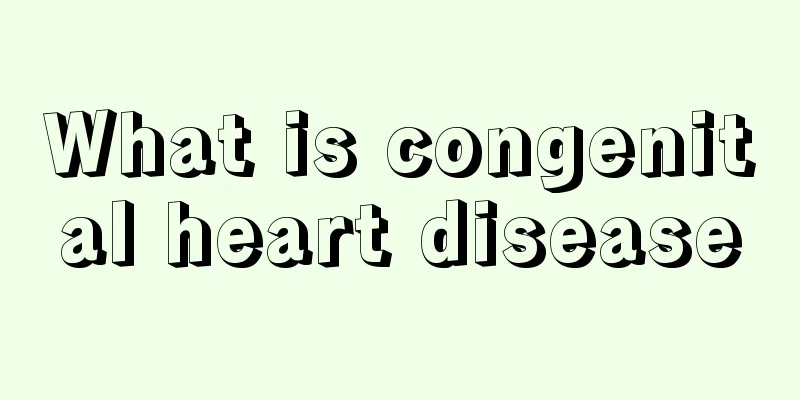What is congenital heart disease

|
Congenital heart disease is familiar to everyone. In TV dramas and movies, the heroines are pitiful and it is also a common plot that the heroines suffer from congenital heart disease. Heart disease is very serious and will continue to bother patients. In addition, patients are not allowed to do strenuous exercise. Friends with congenital heart disease have poor resistance and catching colds is a common occurrence for them. Now, let me give you a detailed introduction to congenital heart disease. Congenital heart disease is the most common type of congenital malformations, accounting for about 28% of all congenital malformations. It refers to anatomical abnormalities caused by formation disorders or developmental abnormalities of the heart and large blood vessels during embryonic development, or the failure of channels that should close automatically after birth to close (normal in the fetus). The incidence of congenital heart disease cannot be underestimated, accounting for 0.4% to 1% of live births, which means that there are 150,000 to 200,000 new patients with congenital heart disease in my country every year. The spectrum of congenital heart disease is particularly broad, including hundreds of specific types. Some patients may have multiple malformations at the same time, and the symptoms vary greatly. The mildest case may be asymptomatic throughout life, while the most severe case may show severe symptoms from birth such as hypoxia, shock, and even death. Based on hemodynamics and pathophysiological changes, congenital heart disease can be divided into cyanotic or non-cyanotic types, and can also be divided into three categories according to the presence or absence of shunt: no shunt (such as pulmonary artery stenosis, aortic coarctation), left-to-right shunt (such as atrial septal defect, ventricular septal defect, patent ductus arteriosus) and right-to-left shunt (such as tetralogy of Fallot, transposition of the great vessels). A small number of congenital heart diseases have the opportunity to heal themselves before the age of 5. Another small number of patients have mild deformities that have no obvious effect on circulatory function and do not require any treatment, but most patients require surgical treatment to correct the deformity. With the rapid development of medical technology, the effect of surgery has been greatly improved. At present, most patients can recover to normal like normal people if they receive timely surgical treatment. Their growth and development will not be affected and they can meet the needs of ordinary work, study and life. There are many types of congenital heart disease, and their clinical manifestations mainly depend on the size and complexity of the malformation. Complex and severe malformations can cause serious symptoms shortly after birth and even be life-threatening. It should be noted that some simple malformations such as ventricular septal defect and patent ductus arteriosus may not have obvious symptoms in the early stages, but the disease may still potentially develop and worsen, and requires timely diagnosis and treatment to avoid losing the opportunity for surgery. Generally, the diagnosis can be made through symptoms, signs, electrocardiogram, X-ray and echocardiogram, and the hemodynamic changes, degree and scope of the lesions can be estimated to determine the treatment plan. For congenital heart diseases with multiple malformations and complex and difficult conditions, specialists will selectively use three-dimensional CT examinations, cardiac catheter examinations or cardiovascular angiography to understand the extent, type and scope of the disease, make a clear diagnosis through comprehensive analysis, and provide guidance for the formulation of treatment plans. The surgical method for congenital heart disease is mainly determined based on comprehensive factors such as the type of heart malformation and the degree of pathophysiological changes. The surgical methods can be divided into three categories: radical surgery, palliative surgery, and heart transplantation. (1) Radical surgery can restore the patient's heart anatomy to a normal structure. (2) Palliative surgery can only improve symptoms but not cure the disease. It is mainly used for complex congenital heart disease for which there is currently no cure, such as modified Glenn and Fontan surgeries, or as a preparatory surgery to promote the growth and development of the originally underdeveloped structures and create conditions for radical surgery, such as systemic-pulmonary shunt surgery. (3) Heart transplantation is mainly used for terminal heart disease and complex congenital heart disease that cannot be treated with current surgical methods. Especially in the early stages of pregnancy, actively prevent rubella, influenza and other rubella viral diseases. Pregnant women should avoid taking medications as much as possible. If they must take any medications, they must do so under the guidance of a doctor. Because the disease is congenital, it is not necessarily passed down from parents to babies. Sometimes the external environment can also affect the baby. Therefore, pregnant women should not play computer games frequently. Radiation is very bad for expectant mothers. It is best not to travel to plateaus, mainly because oxygen is scarce and it is now found that the incidence rate of diseases in plateaus is much higher than in plains. |
<<: Will chronic nephritis cause fainting?
>>: What should I do if poor sleep is caused by insufficient Qi and blood?
Recommend
Does dopamine have metabolic and nutritional side effects?
The main side effect of dopamine is that it affec...
What are the effects of ginseng seeds
Ginseng seed is the name of a traditional Chinese...
Is it good to eat a banana before going to bed? The truth is this
Is it good to eat a banana before going to bed? T...
Why does urine smell like rotten eggs?
Under normal circumstances, urine does not have a...
How should patients with melanoma be cared for
With the development of time and the changes in l...
Is physical height increase effective?
I believe that many female friends usually use ph...
What are the dangers of not treating glioma
Relevant oncology experts said that glioma is one...
How long is the shelf life of dried persimmon
The production of persimmon cake is actually to d...
Can washing your face with milk remove acne?
Washing your face with milk has many benefits for...
How do patients with bladder cancer take care of themselves after surgery
Cystitis is a disease that has a great impact on ...
Can I sleep in the same bed after a fracture?
Fracture is a common medical condition in life. I...
What are the factors for successful surgery of esophageal cancer
Esophageal cancer is a malignant tumor that occur...
Is it serious to have blood in stool occasionally
Blood in the stool is a relatively serious sympto...
What medicine should I take for red and itchy face allergies
Everyone should have their own allergens, but som...
Will kidney deficiency cause headaches?
Modern people are under great pressure in life, a...









